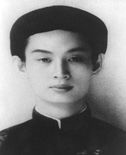PHẬT GIÁO HÒA HẢO
HARMONY BUDDHISM
The Non-Being versus the Being
"Being" can be defined as follow:
The three kinds of appearance:
(1) In logic, the three kinds of percepts:
(a) 標相 inferential, as fire is inferred from smoke;
(b) 形相 formal or spatial, as length, breadth, etc.;
(c) 體相 qualitative, as heat is in fire, etc.
(2) In abstract terms, three kinds of concepts:
(a) 假名相 names, which are merely indications of the temporal;
(c) 無相相 the formless—
All three are incorrect positions.
The three Schools of 法相宗, 破相宗, and 法性宗 q.v., representing the ideas of 空, 假, and 不 空假, i.e. unreality, a temporary reality, and neither; or absolute, relative, and neither, each suit a level of practice and wisdom in the learners. Therefore, the third level is the middle ground cognition of material and non-material, being/existence and non-being/non-existence, called the Middle School中宗. 中宗 The school or principle of the mean, represented by the 法相宗 Dharmalakṣaṇa school, which divides the Buddha's teaching into three periods, the first in which he preached 有 existence, the second 空 non-existence, the third 中 neither, something 'between' or above them, e. g. a realm of pure spirit, vide the 深密經Saṃdhinirmocanav-sūtraand the Lotus Sutra.
If you use the material/form or sound to look for me, you actually practice the wrong way, and will never recognize Tathāgata (Sanscrit: Tathāgata; vi: Như Lai; Zh: 如来), Buddha said. What is tangible is not real, but illusionary and imaginary. If you sense it but don’t cling to it, you may recognize Tathāgata.
He added. In ‘Awakening’ Volume IV ̣(Giác Mê Tâm Kệ), Lord Master Huynh said: “Emptiness is the True Being.” ̣(Vô pháp tướng mới là thiệt tướng). He also said in the ‘No More Superstitions’ poem.
“Seek the miraculous Way in the Buddha Dharma,
And you will comprehend the contents of Vacuum .”
̣(“Tìm tỏi Đạo mầu trong Phật pháp, Cho đời hiểu rõ lý chơn không”).
Chú Giải QIII: “Tìm Cái Có trong cái Không"
Non-Being or Vacuum, a Buddhist lexicon, by which every phenomenon is formed by its concept, and does not have its own entity.
b) 法相 dharmas, or "things";

